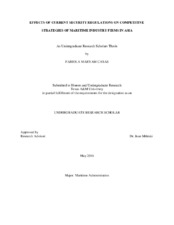| dc.description.abstract | The effects of current maritime port security regulation implementation on the perceived competitiveness of Asian ports are examined in this study. This project attempts to measure these effects by distributing surveys via email in order to enlarge the scope on prior research concerning European Union and United States maritime port security regulations. This expansion will allow for setting the framework to compare and contrast how ports around the world use their assets and strategize competitively. This project analyzes many features of Asian ports, and this comparative analysis could be beneficial to the ports which can adopt the strategies of the most competitive ports of Asia. The following specific research question will be explored: How do Asian ports’ core competencies differ from those in the EU and the U.S. with security measures already in place?
Prior research has studied the effect of EU and U.S. port security regulation on the competitive strategies of maritime industry firms and port infrastructure. This research surveyed EU and U.S. ports to see what each port thought its core competence was in its organization, while this project surveyed Asian ports to compare differences in responses in order to expand upon the findings of past research (Stone, 2013; Farrell, 2014). This survey was distributed through email, and the contact information for Asian ports was retrieved from Sea-Web Database.
Structured by the Resource-Based Strategic Theory, the survey asks ports to determine whether their assets are unique, valuable, not easily imitated, not easily substituted, specific to that firm, or hold no competitive advantage. In accordance with this theory, this study found that the intangible assets and resources of a port are perceived to give them a competitive advantage, as it compared the physical, technological, planning security, ongoing management resources, financial, and human assets and resources. | en |


